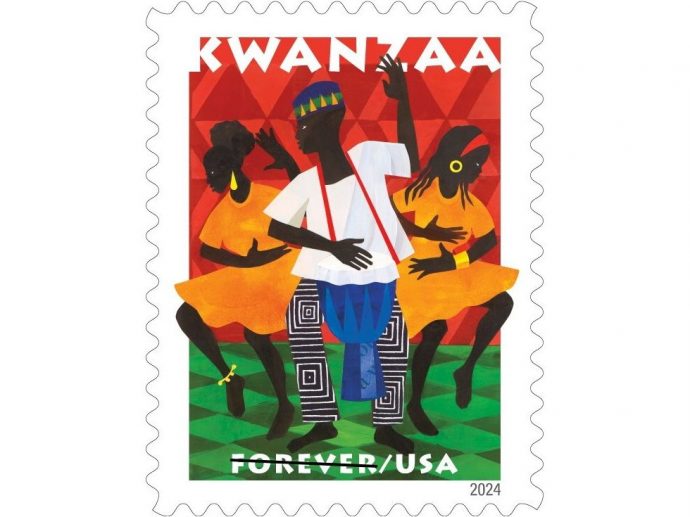Categories more
- Adventures (17)
- Arts / Collectables (15)
- Automotive (37)
- Aviation (11)
- Bath, Body, & Health (77)
- Children (6)
- Cigars / Spirits (32)
- Cuisine (16)
- Design/Architecture (22)
- Electronics (13)
- Entertainment (4)
- Event Planning (5)
- Fashion (46)
- Finance (9)
- Gifts / Misc (6)
- Home Decor (45)
- Jewelry (41)
- Pets (3)
- Philanthropy (1)
- Real Estate (16)
- Services (23)
- Sports / Golf (14)
- Vacation / Travel (60)
- Watches / Pens (15)
- Wines / Vines (24)
- Yachting / Boating (17)
Published
11/07/2024 by U.S. Postal ServiceThe United States Postal Service today unveiled a new stamp design honoring Kwanzaa, a Pan-African American holiday observed annually from Dec. 26 to Jan. 1.
The ceremony, in partnership with the Association for the Study of African American Life and History (ASALH), took place at the Heinz History Center in Pittsburgh.
"The Postal Service's goal is to create stamps that resonate with people from all walks of life," said Roderick Sallay, USPS director of legislative policy and strategy development. "The issuance of this Kwanzaa stamp is a powerful symbol of the enduring principles of the holiday. It recognizes Kwanzaa's ability to inspire and unite people through its emphasis on community, self-determination and collective responsibility. By placing these values on a stamp, we affirm their universal relevance and their potential to enrich our daily lives."
Joining Sallay for the ceremony were master of ceremonies Jourdan Hicks, a community correspondent and community educator; William M. Dulaney, ASALH president; Ekua Holmes, the stamp artist; Sala Udin, a community organizer; Anyah Nancy, vocalist; and the Balafon West African Dance Ensemble.
"The Association for the Study of African American Life and History commends the United States Postal Service for its recognition of the extreme cultural significance of Kwanzaa and its seven foundational principles," said Dulaney. "By its issuance of a holiday stamp that honors Pan-African family and culture, the USPS affirms its belief that diversity is America's strength, and thereby invites all Americans to celebrate with us in late December."
Each year, millions of African Americans gather with friends and family throughout the week of Kwanzaa to honor the Pan-African holiday's seven founding principles — unity (umoja), self-determination (kujichagulia), collective work and responsibility (ujima), cooperative economics (ujamaa), purpose (nia), creativity (kuumba) and faith (imani).
Kwanzaa is a festive time for rejoicing in the prospect of health, prosperity and good luck in the coming year. It is also a time for contemplation and recollection of past hardships, faced by both individuals and communities, and the ways in which history can inform and affect future happiness.
With origins in ancient and modern first-harvest festivities occurring across the African continent, Kwanzaa incorporates and reimagines many communal traditions as a contemporary celebration and reaffirmation of African American culture
The Postal Service's 10th Kwanzaa stamp since 1997 was inspired by a live performance by dancers from OrigiNation Cultural Arts Center, witnessed by artist Ekua Holmes, during a Kwanzaa event in Roxbury, MA. The stamp depicts three young performers — a male drummer and behind and to either side of him, two female dancers. He wears a dark blue, green, and orange kufi; a white shirt, and pants with a geometric black and white mud cloth-like pattern. His djembe — blue with a white drumhead — hangs from his neck by a red strap. The two dancers wear orange dresses and gold jewelry. One has a red hair band and all three figures have silhouetted black skin and hair. The floor beneath their feet is diamond patterned in shades of green, while the background features triangles in shades of red. Each dancer extends a knee and a bit of orange skirt beyond the image frame, into the white margin of the stamp.
The composition highlights the colors of the Pan-African flag — black, red, and green and West African designs on the floor, background and the drummer's pants.
Ethel Kessler, an art director for USPS, designed the stamp with original artwork by Holmes.
The Kwanzaa stamp is being issued as a Forever stamp in panes of 20. These Forever stamps will always be equal in value to the current First-Class Mail 1-ounce price. News of the Kwanzaa stamps are being shared with the hashtag #KwanzaaStamps.















